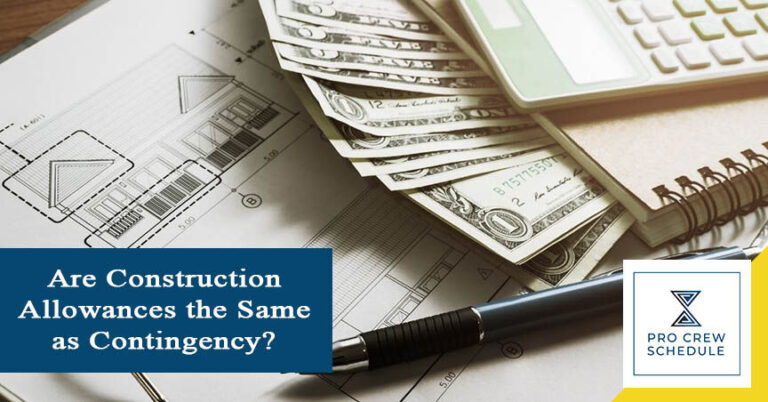In managing construction, we are used to having a strict and immovable budget and timeline that serve as a roadmap throughout a project’s lifecycle. Everything must be done perfectly and on the dot without wasting time and money. However, every seasoned professional in the construction industry can agree on one thing – this is not always the case.
Compared to other industries and businesses, the construction industry has been operating with various external factors and uncertainties towards completing a project. These factors cannot be predicted and are out of control; thus, we have introduced the idea of flexibility throughout a project’s duration. With this learning, construction professionals have accepted allowances during operations and additional contingency in the budget for a more realistic timeline and budget.
While allowance and contingency serve as a “flexibility” factor in managing construction projects, they have key differences and purposes. Now, let’s look at each of them.
What are Allowances in Construction?
In the construction industry, an allowance is considered as the amount included in the contract for a specific material or service, the breakdown of which, such as how much and how many will it be, still needs to be determined during the signing of the contract.
In a nutshell, it is the average projected price for yet-to-be-determined construction items until a more accurate price is obtained during the project operations. Construction allowances allow the team to have an overview of the total project costs and set a budget in the early phases of the project, even before any construction selection starts.
Eventually, the final project cost is determined as the project moves on and the specific items’ costs are clear. If the total cost exceeds the allowance, the contractor will increase the contract’s total price. If the opposite case occurs, the project’s total cost lessens, and the contractor must return the variance to the project owner.
What are the Two Main Types of Construction Allowances?
To better understand the concept of allowances in the industry, below are the two types of allowances typically included in construction contracts.
1. Material Allowances
Material allowances are included in contracts to allow flexibility in building materials selection, such as the options for finishes, lighting, flooring, or any other architectural component of the project. As a rule of thumb, such allowances vary depending on the project owner’s final pick among the selections.
For instance, the owner can decide between two building materials: flooring tiles and wall accents. If the owner hasn’t chosen the final item to use when estimating a budget during the contract creation phase, then the contractor cannot finalize the project’s final price. Hence, allot an allowance for these selections might be reasonable and necessary.
The schedule where a certain selection must be decided can be tracked in construction scheduling software, so your team can be informed when a certain selection needs to be decided by the owner.
It’s important to highlight that material allowances cover only the material costs. They do not include the labor cost to order, deliver, or install certain materials.
2. Installation Allowances
Installation allowances are allotted for the scope of work that cannot be finalized until the work is performed and deemed completed.
An example where installation cost is needed is when the soil where a building will be erected hasn’t undergone soil poisoning treatment. In this scenario, the contractor can’t estimate the cost of laying the structural foundations since soil poisoning activity may be needed. Installation allowances help cover this kind of scenario and similar uncertainties on a construction site.
Allowances should be negotiated between the project owner and contractor during the signing of the contract and before any work begins on-site. Both parties should establish plans when under and over-allowance costs happen to ensure both sides are treated fairly.
What are Consideration in Establishing Allowances?
Learning the advantages and disadvantages of a construction allowance can help create a smoother contract-making experience for the project owner and contractor, especially when the construction team is concerned. Below are some of the important considerations in creating allowances clauses in your contract:
- Construction allowance, as much as possible, should be avoided. The more construction allowances are stipulated, the more opportunities for conflict between the two parties. Project owners should sign a project contract with a crystal-clear idea of what the completed project will look like. Contractors should encourage the owner to finalize all the material selections before finalizing the contract.
- Contractors should inform their clients about allowances, how they may positively and negatively affect the construction contract, and how important decisions will be put off until the operations have begun. Owners should ask questions when they see allowances existing in their contracts.
- Project owners should familiarize themselves with material costs. Consequently, contractors should be able to explain every instance for each allowance clause in the contract and how the final project cost will be affected in general.
- Contractors should prepare a work order for the allowance immediately before starting work or purchasing the material. Customers should be strict on seeing work orders for when allowances come into play in any project phase.
- Contractors should be strict that changes, when cost allowances are involved, should be approved by the owner before they release any money for the new materials or labor. Owners should request that the contractor secure approval before spending additional money on materials or labor costs.
What is Construction Contingency?
Construction contingency is a pre-determined cost allocated to cover potential changes or risks in the agreed project scope that are unanticipated during the planning phase.
Projects with allocated contingency costs are certainly protected against scheduling delays, overruns, and any other risks that may arise throughout the project lifecycle. While preparing for every contingency factor in advance is impossible, a well-defined budget plan will guarantee a smooth workflow. Depending on the project scope, reasons, and the pre-planning considerations may differ.
What are the Factors Affecting Contingency Costs?
1. Weather Conditions
Depending on the project’s location, seasonal weather can pose a risk for operations. For example, contingency funds should be allotted to cover the materials protection costs if you are working on exterior architectural components during winter or in a high-altitude location.
2. Material and Labor Cost Inflation
Allocating contingency funds can help your team be ready to respond quickly to changing market conditions. While most of the materials can be ordered in bulk and in advance, their price may fluctuate before delivery, affecting your construction budget.
The workforce is also not safe from inflation and inflation of cost. Allocating a contingency cost allows more flexibility in construction crew management and ensures that all workers are compensated well, even if another virus hits the globe.
3. Cost Overruns
It is wise to have a precisely planned contingency fund to avoid any extra costs due to miscalculations or changes in the project scope. Contingency fund often includes:
- Overages due to extra labor hours.
- Supplementary building materials.
- Other unexpected circumstances on-site.
4. Design Errors
Inaccurate or incomplete designs and last-minute modifications can lead to more labor hours, material shortages, and issues that can cause delays during construction. Companies practicing contingency planning secure their projects with a budget to cover any extra costs caused by such events.
5. Unexpected Site Conditions
Equipment accidents or machinery malfunctions are unexpected site events that can burden your project. Not paying close attention during the preparation phase can substantially increase project complexity and costs in the long run.
Contractors can respond to such accidents with allotted contingency funds while keeping their timeline and budget intact. It’s a win-win for all parties involved: the owner, subcontractors, supplier, and contractor.
How are Allowances Different from Contingency in the Construction Industry?
Construction allowances and contingencies are two factors in the industry that, most of the time, are used interchangeably. However, from what we have discussed, it is clear that there are differences between the two.
Allowances are identified at the start of a project. This means construction allowances are anticipated from the get-go – but there are still uncertainties as to what decision will be made regarding some selections. Still, the allowance provides a good estimate for the options until the actual price can be finalized.
Meanwhile, contingencies are completely unknown factors. Yes, the contingency fund anticipates future problems – but these aren’t identified from the start and may never even happen in real life.
Key Takeaway
Even though many factors cannot be controlled by industry, there are contingencies and allowances that we can establish ahead of time to ensure our peace of mind throughout the project duration. These two, integrated with construction management software with crew schedule management, inventory management, time-tracker, worker delegation features, and more— workflow can be streamlined, and adjustments can be made efficiently.
Pro Crew Schedule has everything you need to run your construction business successfully— and it’s all in one place and is easy to use.







